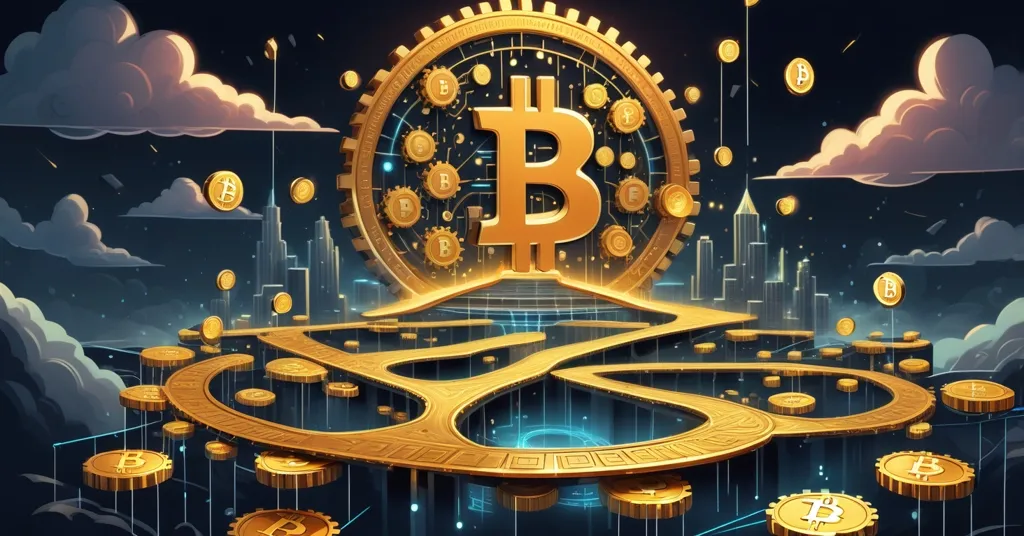XRP ETFs Spark Hype as Bitcoin Hyper Raises $27M for Layer 2 Innovation

XRP ETFs Ignite Bullish Hopes: Big Money and Bitcoin Hyper Innovation Take Center Stage
A wave of institutional interest is crashing into the crypto market just in time for the holidays, with XRP at the forefront thanks to a flurry of new exchange-traded funds (ETFs). Meanwhile, a promising Bitcoin Layer 2 solution, Bitcoin Hyper, is making noise with a hefty presale raise. These developments hint at a maturing digital asset space, but as always, the road ahead is paved with both opportunity and uncertainty.
- XRP ETF Surge: Grayscale and Bitwise launch XRP ETFs, with Franklin Templeton possibly joining before Thanksgiving.
- XRP Price Watch: Rebound from $1.90 to $2.05, with $2.20 as the make-or-break resistance level.
- Bitcoin Hyper ($HYPER): Bitcoin Layer 2 project raises $27 million, aiming to bring DeFi to BTC with Solana’s speed.
XRP ETFs: Wall Street’s Big Bet on a Controversial Coin
The crypto market has been a bare-knuckle brawl lately, and XRP is stepping into the ring with some heavyweight backup. The Grayscale XRP Trust ETF (GXRP) has officially launched, following Bitwise’s XRP ETF debut just last week. Word on the street is that financial titan Franklin Templeton might throw its hat in with its own XRP ETF before Thanksgiving, amplifying the buzz around Ripple’s native token. For those new to the scene, ETFs are investment vehicles traded on traditional stock exchanges that track the price of an asset like XRP. They’re a bridge between old-school finance and the wild world of crypto, allowing institutional investors to gain exposure without wrestling with unregulated exchanges or private wallets. This is a significant step for XRP, which has been slugging it out with the U.S. Securities and Exchange Commission (SEC) since December 2020 over allegations that it’s an unregistered security due to Ripple’s centralized control over its issuance and distribution.
These ETF launches signal that traditional finance might finally be warming up to XRP, despite its regulatory baggage. After years in the SEC’s crosshairs—with partial courtroom wins for Ripple, including a 2023 ruling that XRP isn’t a security in secondary market transactions, but still facing fines and appeals—these products suggest a shift in perception. They’re spot ETFs, meaning they directly hold XRP (or track its price closely), not futures contracts, and while primarily geared toward institutional players, some retail investors can access them through brokerage accounts, albeit with fees that often outstrip direct crypto ownership. But let’s not pop the champagne just yet. ETFs don’t erase the risk of a regulatory sledgehammer if the SEC’s case against Ripple takes a nasty turn. A final ruling labeling XRP a security could tank sentiment overnight, ETF or no ETF. Plus, Ripple’s heavy influence over XRP’s supply raises centralization concerns that Bitcoin maximalists like us can’t ignore. Is this institutional embrace a genuine vote of confidence, or just Wall Street chasing the next shiny object?
XRP Price Analysis: Breaking the Curse of $2.20
On the price front, XRP is showing flickers of life after a brutal stretch. Following four consecutive weeks of losses, it dug in at a support level of $1.90 before clawing its way back to $2.05 as of early November 2023, posting a modest 1.3% gain in the last 24 hours. Now, the spotlight is on $2.20, a previous low on the daily chart and a critical resistance point. Resistance levels are price zones where selling pressure often kicks in, as traders lock in profits or doubt further upside—think of them as psychological walls. If XRP smashes through $2.20, it could signal to the market that a trend reversal is underway, shifting from bearish gloom to bullish hope. The next stop would be $2.60, which lines up with the 200-day Exponential Moving Average (EMA), a tool traders use to gauge an asset’s average price over the past 200 days for long-term trend insights. If momentum really builds, a mid-term target of $3.50 isn’t out of the question.
Before we start dreaming of moonshots, let’s cut the crap—XRP hitting $3.50 isn’t a sure thing, and anyone peddling guaranteed price predictions is likely trying to sell you a bag of hot air. Crypto markets are a volatile mess, and XRP’s fate is still tethered to Ripple’s legal drama. A negative ruling could send it spiraling back to $1.90 or lower, regardless of ETF hype. Even without regulatory shocks, resistance levels like $2.20 often act as brick walls because enough traders see them as a cue to sell, flooding the market with supply. Trading volume data post-ETF launch shows a slight uptick in XRP activity, but it’s hardly a flood of institutional cash just yet. So while the tailwind of big money interest in XRP is real, the road to a sustained breakout is anything but smooth. Can XRP finally shake off its cursed reputation, or is this just another false dawn?
Bitcoin Hyper: A Layer 2 Lifeline for Bitcoin’s Utility
While altcoins like XRP court Wall Street, Bitcoin isn’t sitting on its laurels. Enter Bitcoin Hyper ($HYPER), a Layer 2 solution that’s caught our eye with a whopping $27 million raised in its presale. Layer 2 technologies are protocols built atop a base blockchain like Bitcoin to boost scalability, speed, and cost-efficiency while still tapping into the main chain’s ironclad security. Bitcoin Hyper takes a unique swing by integrating Solana’s high-speed, low-cost infrastructure—yes, the same Solana that’s been a DeFi darling despite its occasional network hiccups. The goal? To bring decentralized finance (DeFi) capabilities such as staking, lending, and yield farming to Bitcoin holders, who’ve long been stuck treating BTC as digital gold with little practical utility beyond holding.
The magic behind Bitcoin Hyper lies in its Hyper Bridge, a digital mechanism that locks up your Bitcoin securely in a wallet on the base layer while minting equivalent tokens on Hyper’s Layer 2 network. These tokens can then be used for fast, dirt-cheap transactions and DeFi applications, all while being backed by the real BTC sitting safely in the vault. It’s a compelling pitch: keep Bitcoin’s unparalleled security as the foundation, but layer on Solana’s efficiency to make BTC usable in ways it’s never been before. With $27 million in presale funds from undisclosed backers (a detail that raises an eyebrow or two), Bitcoin Hyper is positioning itself as a game-changer. But let’s not get swept up in the hype—presales are a damn minefield in crypto, littered with projects that rake in cash only to crash and burn. Solana’s history of outages doesn’t exactly inspire confidence either; if Hyper leans too hard on a flaky network, users could get burned. And where’s the transparency? No public whitepaper or detailed roadmap has surfaced yet, which is a red flag for a project asking for millions.
As Bitcoin purists, we’re naturally wary of anything that risks diluting BTC’s simplicity as a store of value. That said, there’s no denying that Layer 2 solutions like Hyper fill a glaring gap—Bitcoin isn’t built for the quick, cheap transactions DeFi demands. Compare it to other Layer 2 players like the Lightning Network, which focuses on microtransactions but struggles with broader DeFi adoption, or Stacks, which aims for smart contracts but lacks Solana’s raw speed. If Hyper delivers without compromising Bitcoin’s core, it could accelerate BTC’s dominance in new financial frontiers. But that’s a big “if.” Execution is everything, and investors should tread lightly until the tech proves itself beyond slick marketing.
The Bigger Picture: Risks and Rewards in Crypto’s Evolution
Zooming out, the twin stories of XRP ETFs and Bitcoin Hyper paint a fascinating portrait of a crypto market growing up—sort of. On one hand, institutional products like XRP ETFs scream mainstream acceptance, suggesting that traditional finance is ready to play ball with digital assets, even controversial ones. On the other, innovations like Bitcoin Hyper highlight the relentless drive to solve real problems like scalability and usability, pushing decentralization forward in ways that could redefine money itself. As champions of effective accelerationism, we’re thrilled to see these leaps, whether it’s altcoins like XRP carving out payment niches or Bitcoin evolving through layered tech. Disruption of the status quo? Hell yes, sign us up.
But let’s keep our heads screwed on straight. Every silver lining in crypto comes with a storm cloud. XRP’s ETF momentum could evaporate if the SEC lands a knockout punch, and centralization risks with Ripple remain a bitter pill for decentralization purists. Bitcoin Hyper’s presale success is intriguing, but unproven tech and Solana’s shaky track record mean it’s far from a safe bet. The crypto space is maturing, sure, but it’s still a wild west where scams, rug pulls, and regulatory ambushes lurk around every corner. These developments aren’t just shiny new toys—they’re battlegrounds where the future of finance is being forged. Are XRP ETFs and Bitcoin Hyper the dawn of a transformative era, or just the latest distractions in crypto’s endless hype cycle? Only time, and the market’s brutal honesty, will tell.
Key Takeaways and Questions
- What’s fueling the excitement around XRP ETFs in 2023?
Major firms like Grayscale and Bitwise have rolled out XRP ETFs, with Franklin Templeton potentially joining by Thanksgiving. These products reflect growing institutional trust in XRP, hinting at broader adoption despite Ripple’s SEC legal fight. - Can XRP price break through the critical $2.20 resistance?
XRP has edged up from $1.90 to $2.05 recently, but $2.20 is the line in the sand. Surpassing it could spark a bullish trend toward $2.60 or $3.50, though regulatory risks and market volatility loom large. - How does Bitcoin Hyper plan to boost Bitcoin’s functionality?
Bitcoin Hyper, a Layer 2 solution, uses Solana’s speed to enable DeFi features like staking and lending for BTC holders. Its Hyper Bridge secures Bitcoin while creating tokens for fast, cheap transactions, backed by a $27 million presale. - Should Bitcoin maximalists embrace Layer 2 projects like Hyper?
While Bitcoin’s core strength as a store of value remains paramount, Hyper addresses DeFi gaps BTC doesn’t fill. If it maintains security, it could enhance Bitcoin’s reach—though unproven tech warrants skepticism. - Are XRP ETFs and Bitcoin Hyper safe investments for crypto enthusiasts?
Not by a long shot. XRP faces regulatory peril that could derail ETF gains, and Bitcoin Hyper’s reliance on Solana plus presale opacity scream risk. Optimism is fine, but caution is non-negotiable in this game.



